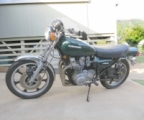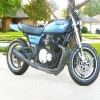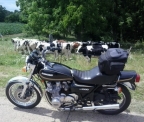- Posts: 743
- Thank you received: 10
Death, just moments away
- Kitten Tooth
-
 Topic Author
Topic Author
- Offline
- User

1981 Kawasaki KZ1000-K LTD
1983 Suzuki GS300L-D
1982 Suzuki GS300L-Z sold:(
1976 KZ400D3
1973 Z900... I WISH
DO A BARREL ROLL!!
Please Log in or Create an account to join the conversation.
- Kapahulu
-

- Offline
- User
This is a great video. Also the Isle of Man but I cringe everytime I see that guy cartwheel in the air near that rock wall.VenturaRider wrote: Here's a old English video on weave and wobbles. Theres also some cool shots with a 73 Z1 in the demo.
1978 KZ1000, 1976 KZ900, 1975 H2, 1973 H1, 1973 H2, 1978 RD400, 1977 RD400, 1974 RD350
2strokeworld.com
Please Log in or Create an account to join the conversation.
- testarossa
-

- Offline
- User
- Attack life, it's only trying to kill you.
- Posts: 3678
- Thank you received: 82
650ed wrote: Here's a guy who knows how to go through a turn like a man.........
Jamie Hacking.
I miss watching him race. He always made things interesting. Often too interesting for the sponsors. :evil:
1978 KZ1000 A2 Click--->Build Thread
2004 ZX-10R
2007 Harley Sportster 1200
2020 Harley Street Glide Special
Angola, IN
Please Log in or Create an account to join the conversation.
- Kitten Tooth
-
 Topic Author
Topic Author
- Offline
- User
- Posts: 743
- Thank you received: 10
wireman wrote:
Ya should of tried riding a brand new 77 kz1000,they had lots of issues with pretty much every part on them! :sick: :woohoo:650ed wrote: I have no personal experience with a Z1 or KZ900, but the KZ650 and KZ1000 didn't have any wobble at any speed when new. Ed
Note: I can say with 100% confidence that the KZ650-C1 did not have any inherent speed wobble when new. Please understand my comment is not based on theory, hearsay, or myth. It is based on my buying a new KZ650-C1 off the showroom floor in April 1977 and riding it for more than 35 years (and I still ride it). For the first 32 years there was absolutely no wobble of any sort at any speed. The shocks on the KZ650 wore out after only 2 years at about 12,000 miles and were replaced with better units. The worn out original shocks made handling in the turns inadequate, but did not generate speed wobble. Three years ago, at approximately 47,000 miles, I experienced a consistent 90+ mph speed wobble because of a bad tire(s). That was the first time the bike ever had a wobble. After replacing the tires the wobble is totally gone. Along with the tires I replaced the steering stem bearings (which had dimpled) with tapered roller bearings and installed new swing arm bushings, but the cause of the problem was the tires.
The year after I bought my bike a good friend bought a new (1978) KZ1000-A2. I rode that bike up to speed and experienced no wobble. My friend and I logged many many miles together, often taking forays into triple digit speeds, and he never experienced wobble. He did not keep his bike as long as I kept mine, but suffice it to say the bike had no wobble when new.
Folks can express different opinions on the internet, and some may have experienced wobble due to bad tires or other components, or even manufacturing defects, and I certainly cannot speak to every model made. However, I can say without a doubt that the 2 models I mentioned had no design related speed wobble issues. If they did, the bikes my friend and I rode would have experienced that problem because I don't believe a manufacturing fluke would prevent a design problem from showing up. Ed
78 gave them another year to work the bugs out,but between those junk dont-grip tires and the factory shocks and flexing swingarms they were still a dressed up pig on stilts with a big motor in stock form! :laugh:
Good aftermarket rubber and shocks made a night/day differance though
I heard KZs had their share of problems. Guessing its all true? hahaha thinking they were the boats of the motorcycle world

1981 Kawasaki KZ1000-K LTD
1983 Suzuki GS300L-D
1982 Suzuki GS300L-Z sold:(
1976 KZ400D3
1973 Z900... I WISH
DO A BARREL ROLL!!
Please Log in or Create an account to join the conversation.
- faffi
-
- Offline
- User
- Posts: 554
- Thank you received: 36
1977 KZ650B1
1980 F1 engine
B1 3-phase alternator
B1 Points ignition
Please Log in or Create an account to join the conversation.
- bluej58
-

- Offline
- Sustaining Member
- The chrome don't get you home
- Posts: 2481
- Thank you received: 511
" Keep a firm grip on the handle bars with out locking arms or fighting the steering.
Smoothly ease off the throttle to slow gradually.
Do not apply brakes, and do not accelerate to try to stop the wobble or weave.
In some cases it helps to shift your body weight forward by leaning over the tank "
They list some of the causes as;
" Excessive weight in the wrong place ,or by mechanical problems such as worn or loose bearings or under inflated or unevenly worn tires "
78 KZ1000 A2A
Please Log in or Create an account to join the conversation.
- faffi
-
- Offline
- User
- Posts: 554
- Thank you received: 36
Ashen and trembling I maneuvered my California Superbike School Kawasaki 636 off the track and into the hot pits, pulling up next to course control and a few of the other coaches. They took one look at me, my white face and shaky hands and asked “what happened?” “Tank-slapper,” I replied sullenly and they all laughed, “welcome to the club!”
I was at Reno Fernley Raceway, coaching with the California Superbike School when I experienced the scariest moment of my riding history that didn’t end up in a crash. I was working with a very fast student, an unassuming guy that I never thought was going to be as fast as he was, but he was blazing, and getting faster and faster each session which meant I had to work!
The layout at Reno Fernley raceway (it has since been added to and modified) was fun and fast with a smooth front section that flowed really nicely. The back section however, was extremely bumpy in a kind of wavy and rippled way, and all morning I had been a little nervous and tentative going through it. It happened later on in the afternoon, I was sitting parked off of the track near the front straightaway when my fast guy student screamed past. I pulled onto the track quickly and raced after him, closing the gap considerably in the first few turns. When he pulled onto the back straight however, he was still about 10 bike lengths ahead of me and I needed to close the gap further if I was going to observe him ride. As coaches we usually follow our students for a lap or two and then get in front and lead them for a lap or two. I twisted the throttle harder to close in and everything was going along fine until I hit one of the bumps so hard it bounced me right out of the seat.
When I came down the bike jerked and bounced and the bars started to shake from side to side, tossing me back and forth with it. I thought I was going down and for an instant, out of sheer panic I clung to the bars and tried to make it stop. Big mistake, the bars started shaking more violently, I was bounced higher and harder in the seat and as much as I tried to hold on to the handlebars I couldn’t. They were literally ripped right from my hands and started slapping into the tank going from lock to lock.
I prepared to eject. I was quite literally about to jump off the bike when an amazing thing happened, the bike started calming down and straightening itself up.
I was so excited, and eager to regain control of my machine that I grabbed at the bars again and the instant I clamped down on them they started shaking wildly again.
This time I smartened up to what was happening and implemented some of the very basic things that I teach every day at the California Superbike School about rider input. Basically, as Keith Code says in his book Twist of the Wrist II, “riders create more problems than motorcycles are designed to handle.”
What he means by that is that the more you interfere with what the bike is trying to do on its own, by holding on too tight, by trying to muscle the bike around, by squirming and wiggling and messing about, the more difficult it is to have a stable bike.
Yes, all these thoughts did zoom through my head as I was flailing around on my bike like a stunned chicken, leaving foot long skid marks trailing behind me.
I squeezed the tank with my knees, raised my butt a little bit off the seat to help soak up bumps with my legs (like a jockey riding a horse) loosened my grip, made my arms like wet noodles and tried to relax while rolling on the throttle. After another series of wild jerks the bike calmed down and I had regained control. Whew.
Then oddly enough I remembered some random comment that a racer had once said to me that at the time had made no sense at all. “If you ever have a tank slapper, remember to pump up the brakes afterwards because it can cause them to not work at all.”
I reached for the brakes as I approached the left hand corner at a high rate of speed and low and behold, no brakes! I pumped wildly, got the bike slowed down enough to make the turn, looked up the track to see my speedy student disappearing in the distance, rode straight for pit exit, and into an awaiting group of shark like coaches who thought my whole experience was funny. Funny?
So what exactly is a tank slapper anyway?
Let’s break it down.
A tank slapper is a rapid, high intensity and unwanted motion of the handlebars back and forth. Literally it is the slapping of the bars from side to side that can get violent enough to actually hit the tank of the motorcycle, hence the name “tankslapper.” The bad news is that they are scary as hell and can cause some pretty nasty crashes. The good news is that there are some very effective techniques you can use to handle them.
What causes tank slappers?
The suspension system on a motorcycle is designed to make the ride more comfortable for the rider and primarily to keep the tires in good contact with the road surface which can include bumps, cracks, pot holes and all manner of imperfections. This system must work while the motorcycle is straight up and down and also during turning when the bike is leaned over, sometimes at very extreme lean angles.
In his book, A Twist of the Wrist II, Keith Code explains, “the process of head shake (which can be the beginnings of a tank slapper) begins when the tire hits a ripple and, along with the suspension, compresses. This throws the wheel slightly off-center. When the suspension and tire release, the wheel is light and flicks back toward a centered position, but again, slightly off-center. Still off-center when it loads again from the next ripple; again it is flicked past its centered position. The cycle of flicking back and forth repeats as the front-end seeks to stabilize through this automatic and necessary self- correcting process. Any bike will do it, and what most riders fail to realize is that this shake is a necessary part of the bike’s suspension system.”
The little wiggle in the front of the bike is how the motorcycle self corrects and gets itself back on track. Ever see a motorcycle race where something, either a tank slapper or a big slide causes the rider to either be ejected from, or fall off the bike? As soon as the rider is no longer on the bike it wiggles a bit, straightens out, keeps on going perfectly straight until it runs out of momentum and falls over. This is a classic example of how a bike, if left to its own devices will sort itself out. Code mentions that, “based on the amount of wiggling, squirming and overuse of controls most riders exhibit, the bike would, if it could, surely ask them to leave. Riders create instability on their own mounts.”
Head shake can be caused by hitting a bump or a ripple in the pavement or it can occur when accelerating hard out of a corner. Hard acceleration can cause the front end to get light or even wheelie which means that the tire is no longer following the road very well, and when it touches back down it can skip or bounce or be off-center, starting off the headshake. Code explains that, “the good news is that if your bike is basically tight (steering head bearings not excessively worn, forks and shock not sticking etc.) the head-shake stays up front and does not transfer to the rest of the bike.”
Eventually, the oscillation will die out on its own, unless we interfere.
How Riders make the situation worse:
Our normal reactions when the handlebars start to slightly shake are to stiffen up on the bars. Keith Code calls this our “survival reactions,” noting that we do not usually choose to get stiff and tight on the bars, our bodies just do it. When we stiffen up the head shake is transferred through our bodies to the whole bike and that is when the shaking can get more violent. Code says that “too tight on the bars is the most common source of motorcycle handling problems.”
How to Prevent a Tank Slapper:
Knowing that gripping the bars too tight is what transfers head shake through the bike and makes it feel like a ferocious tiger ripping a piece of meat into shreds, we can work to prevent a tank slapper from ever occurring by maintaining a relaxed position on the bike at all times. Practice sitting on your bike with your knees gripping the tank for more stability. Sit back a little further in your seat so that your arms have a nice bend in them with your elbows pointed to the ground and then flap em like you’re doing the funky chicken. That’s relaxed, and from that position you can easily use your legs to lift your weight off the seat a little bit, like a jockey on a horse, so that your butt is not banging down hard on the seat. Think light as a feather, one with the bike, Zen and the art of motorcycle riding……
Installing a steering damper is another way to help prevent tank slappers. A steering damper works to limit the travel and intensity of any head shake that the bike is experiencing by damping or soaking up the excess energy. They are necessary on some of the more modern bikes that have aggressive frame geometry, relatively short wheelbases and powerful engines. Dampers are mounted up front so that there is insufficient leverage to transfer shake through the bike. Keep in mind though that a motorcycle with a damper will still shake if you are tight on the bars, so relax!
What to do if you experience a tank slapper:
If you do find yourself in the unfortunate situation of experiencing a tank slapper first hand don’t try to muscle the bike or force it to stop as it will only make it worse. Try to relax your grip on the bars, pinch the tank with your knees and lift your butt off the seat a little bit. Also, don’t chop the throttle as that will put more weight onto the front and potentially make the situation worse. Ideally you want to continue to accelerate if possible to get the weight further to the back of the bike, or at least maintain a steady and smooth throttle.
Popping a wheelie would eliminate a tank slapper immediately because there would no longer be a front wheel bouncing back and forth in an effort to straighten itself out, but I don’t know too many people that could pull off a stunt like that in the middle of a panic situation.
If all else fails, let go. The bike will try to fix itself.
Another important thing to remember is that occasionally very violent tank slappers can force the front brake pads and brake pistons away from the rotors, causing the brakes to go soft or even to fade completely. So, once you regain control of the motorcycle, check your front brakes and if they feel soft then pump the lever a few times until the pressure returns.
Finding yourself in a situation where the motorcycle you are on is suddenly out of control is no doubt a scary predicament. The more knowledge you are able to arm yourself with, the better equipped you are to handle emergency situations, and the more you are able to practice certain techniques (such as being nice and relaxed on the bike at all times) the more likely you will be to actually do it when it is absolutely necessary. It’s a pretty cool feeling to be able to consciously decide to do something that makes a bad situation better.
Ride Safe,
Misti Hurst
www.mistihurst.com
1977 KZ650B1
1980 F1 engine
B1 3-phase alternator
B1 Points ignition
Please Log in or Create an account to join the conversation.
- Medina
-

- Offline
- User
- Posts: 271
- Thank you received: 8
bluej58 wrote: In some cases it helps to shift your body weight forward by leaning over the tank "
Thats the FIRST thing I'd suggest.
experimenting on mine, inducing wobble (slapping handlebars) no hands on bars, leaning forward makes it stop.
your mileage may vary, but works well enough for me, I hope I remember to do that if it starts happening at highway speeds
1981 KZ1100 Vetter "Luminous Navy Blue" DAMN YOU COLOR CODES!
Medina, Oh
My Bike Thread
www.kzrider.com/forum/10-new-members/469298-from-ohio
Please Log in or Create an account to join the conversation.
- imon_2nd
-

- Offline
- User
- Architect & Engineer
- Posts: 31
- Thank you received: 4
The suggestions for fixing speed wobble that are listed above in this thread are excellent.
With one of my bikes in the 1970s, a Honda 500cc cafe racer, I tried many of the ideas mentioned to cure the problem. The fix that finally cured it once and for all was to replace the stock mirrors, which looked stupid anyway. Apparently, they started vibrating at 85 MPH and the whole fork assembly and handlebars resonated. You wouldn't think something as small as mirrors could do that, but they can.
Cheers,
Dave
Keepin' the rubber side down.
Please Log in or Create an account to join the conversation.
